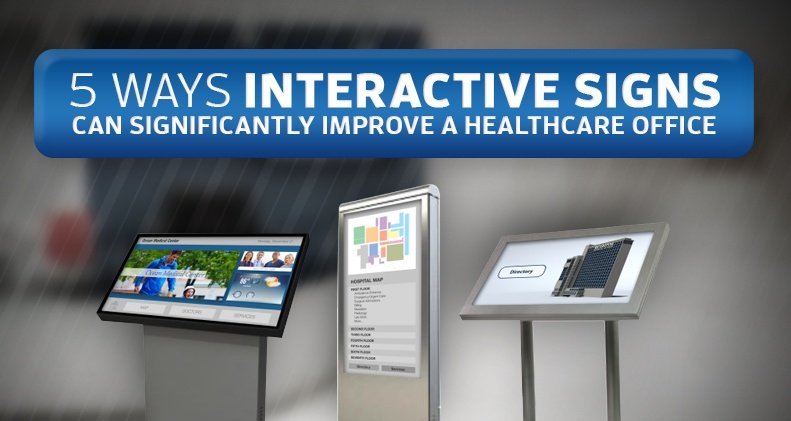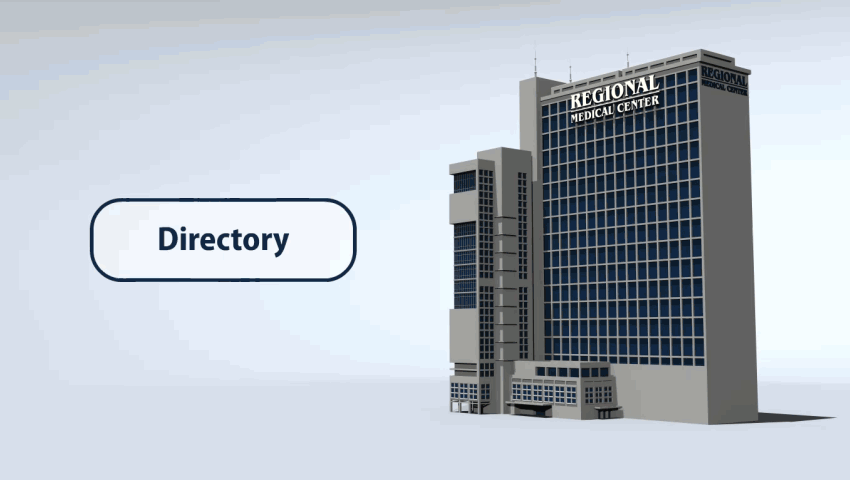
Healthcare offices don’t need interactive signs to run a practice and serve their patients. An absence of engaging content and using human resources and static signs to convey and collect information will get the job done.
But most healthcare offices aren’t satisfied with simply getting the job done.
They want to serve their patients in the most effective and efficient way possible. They want to get the job done in less time, with less stress on staff, while saving money and improving patient satisfaction and health.
To make that improvement, offices committed to achieving the highest level of performance and care can upgrade their office by bringing in interactive signs.
Interactive Signs Help People Find Their Way Faster

Patients benefit from interactive signs — digital screens that enable users to control content — from the minute they walk through the door. New patients can quickly find directions to the office they need by using an interactive wayfinding screen.
With an interactive wayfinding tool, patients can search through directories to find the doctor or office they need. They can then get personalized directions that tell them how to get to their destination from their exact location.
Why It’s an Improvement: The alternative to an interactive wayfinding sign is a static map or a receptionist that guides visitors. Tasking an employee with providing direction is a strain on human resources, and static maps can confuse or mislead patients. An interactive wayfinding tool makes it easier and less stressful for sick and anxious patients and guests to quickly find their location.
[Recommended Reading: 12 Reasons Why We Need Digital Wayfinding Tools in the Healthcare Industry]
Interactive Signs Speed Up the Intake Process
Another strain on human resources in a healthcare office is the work during the patient intake process. An employee is usually tasked with providing and receiving paperwork upon a patient’s arrival.
This process can be drawn out or unnecessarily long when there is a long line of patients in the office. But digital intake kiosks can cut down on the duration of this process. Patients can arrive at the office, visit a check-in kiosk, enter their information, and sit back and relax while they wait for their appointment.
Why It’s an Improvement: The alternative to an interactive check-in kiosk is a manual staff intake process. This requires human resources and may actually delay the process as staff may be unable to serve patients as fast as the kiosk. By using a digital intake process, you can speed up appointment wait-time and gets to patients faster.
Interactive Signs Educate and Resonate with Patients
Many healthcare offices provide patients with additional resources and educational material to help them improve their health. This information is often delivered as brochures, posters, and static signs.
But patients are more apt to pay attention to and remember information when it is delivered through engaging visuals like video and animated graphics. Digital programming delivers information to patients in a way that they enjoy and respond to, and interactive signage takes it one step further.
Why It’s an Improvement: Digital signs are great for connecting with an audience, but interactive signs make information even more memorable and useful. Audiences can select custom content based on their needs, so they only see information that relates directly to them. Unlike static signs or programmed content, the information they find is custom to their needs and interests.
[Recommended Reading: Compelling Reasons Why Visuals Matter More Than You Think]
Interactive Signs Capture Patient Data
Allowing visitors to use interactive content to select and choose their own content has an additional benefit to your office. You can track their activity to collect data on what topics interest them. By discovering what content your audience prefers, you can create additional services, programs, and content that aligns with their needs and interests.
You can also use interactive signage to capture patient data such as email addresses and social media profiles. By adding games, contests, and opt-ins to your content, you can create a way to connect with patients on other platforms.
Why It’s an Improvement: This method of collecting patient data isn’t comparable to any other strategy. You may be able to collect additional contact information through intake paperwork, but patients will be less likely to offer up their email or social media contact information without something in return (like the games, contests, and promotions offered through your signage).
Interactive Signs Save (and Make) Money
Healthcare offices are always evolving, improving,and changing. This can be a problem if you use static signs and print materials to relay information to your clients.
Each time you change your information, you need to reorder print materials. But with digital signage, you can update your information at no cost and in very little time.
Why It’s an Improvement: Using digital and interactive signs saves money by reducing the costs of printing, and it also creates opportunities to bring in additional revenue. When can quickly and affordably update information in your office, you can highlight promotions and offerings that would have otherwise gone unadvertised. It may not be worth it to order new print signs to promote a deal for one week. But with a digital sign, it’s well worth the five to ten minutes you need to change the content on your sign and highlight your timely promotions.
Sure, a health care office can get by without interactive signs in their office.
But why just “get by” when you can upgrade your office environment and better support your staff and patients?
Find out how else you can improve your office and elevate your patient experience by downloading our free ebook, “Everything You Need to Know About Digital Signage.” The guide explains how and why digital signage is rapidly becoming the most effective and efficient way to engage, inform, and entertain patients in your office.